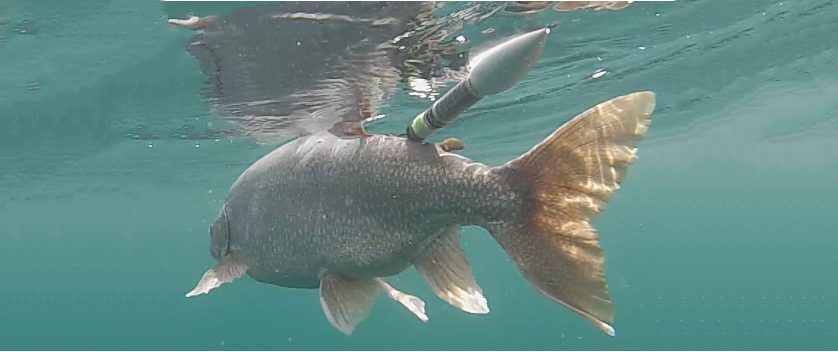← Back
Lake charr ecotypes’ habitats differ

Lake charrs are freshwater fish found in the Laurentian Great Lakes (North America), among others. They nearly disappeared, but restoration was successful at least in Lake Superior. Understanding the different habitats of the lake charr ecotypes can help in restoring them in all of the Great Lakes.
Photo: a lake charr with an Argos archival tag (credit F. Goetz)
Lake charr (Salvelinus namaycush) are freshwater fish living mainly in cold water lakes, in the northmost parts of North America. The populations of lake charr in Lake Superior nearly disappeared, due to overfishing and lampreys, a parasitic fish. Their restoration has been a success, and those populations are currently estimated to be sustainable.
Several subspecies (ecotypes) are found within Lake Superior, though, living in different environments. These include leans, siscowets and redfins lake charrs. Those might not have recovered at the same level, nor are vulnerable to the same threats. The bathythermal distribution of those ecotypes, i.e. the temperature and depth they live in and the seasonal changes of it, can help in better assessing the actual recovery and the vulnerability of each ecotype.
Lake charr tracking using pop-up archival tags
New developments in pop-up archival tags made some usable in freshwater (others have a corrosion-led release which is meant for salt waters). 26 leans, 31 siscowets and 12 redfins lake charrs were tagged with these tags. They were set to record pressure (depth), temperature and acceleration, with a light sensor (for location) / solar panel (powering the tag).
With respect to monitoring fish behavior, the pop-up archival tags continually collect environmental data (while they are attached to the fish) to obtain a continuous and complete profile of habitat.
The tags lasted from 4 to 13 months before popping up and transmitting a position to the Argos satellite system. They were retrieved using the Argos goniometer to upload their whole archived data. Some were not retrieved, and ultimately data from 15 leans, 16 siscowets and 3 redfins were used.
More info about animal tracking with Argos
Restoring lake charr diversity in the other American Great Lakes
The three tracked ecotypes showed different behaviors and habitats in some aspect or another –
Lean lake charr stayed below 20 m throughout the year while the median depth of redfin lake charr was 24–32 m in summer. Siscowets went much deeper, from 103 to 204 m but with four different patterns, depending on the individuals and time of year. All of the tracked lake charr ecotypes stayed at temperatures below 8.5°C and most of their time between 4 and 6°C. Siscowet lake charrs showed a narrower temperature range, with habitat temperatures generally around 4–5°C but not over 12°C. In the meanwhile, lean lake charr was found as low as 0°C in winter but up to 15°C in the summer. Redfin lake charrs are kept at a temperature slightly colder (1–3°C) than leans in summer.
The data obtained from the tags tend to confirm that lake charr ecotypes are highly adaptive and can thrive in cold waters and oligotrophic lakes by using the entire water column. Such characterization of the diverse lake charr ecotypes and of their specific habitats and life histories is essential. It provides an understanding of the diversity present in Lake Superior and should help to maintain it. It could be used also to restore a similar diversity in the whole Laurentian Great Lake system.
Reference
- Jasonowicz, S. Sitar, M. Seider et al., Depth and temperature selection of lake charr (Salvelinus namaycush) ecotypes in Lake Superior revealed by popup satellite archival tags, Journal of Great Lakes Research, https://doi.org/10.1016/j.jglr.2022.05.003
